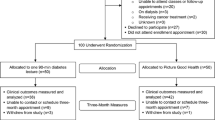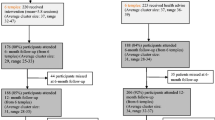Abstract
About 75 % of African-Americans (AAs) ages 20 or older are overweight and nearly 50 % are obese, but community-based programs to reduce diabetes risk in AAs are rare. Our objective was to reduce weight and fasting plasma glucose (FPG) and increase physical activity (PA) from baseline to week-12 and to month-12 among overweight AA parishioners through a faith-based adaptation of the Diabetes Prevention Program called Fit Body and Soul (FBAS). We conducted a single-blinded, cluster randomized, community trial in 20 AA churches enrolling 604 AAs, aged 20–64 years with BMI ≥ 25 kg/m2 and without diabetes. The church (and their parishioners) was randomized to FBAS or health education (HE). FBAS participants had a significant difference in adjusted weight loss compared with those in HE (2.62 vs. 0.50 kg, p = 0.001) at 12-weeks and (2.39 vs. −0.465 kg, p = 0.005) at 12-months and were more likely (13 %) than HE participants (3 %) to achieve a 7 % weight loss (p < 0.001) at 12-weeks and a 7 % weight loss (19 vs. 8 %, p < 0.001) at 12-months. There were no significant differences in FPG and PA between arms. Of the 15.2 % of participants with baseline pre-diabetes, those in FBAS had, however, a significant decline in FPG (10.93 mg/dl) at 12-weeks compared with the 4.22 mg/dl increase in HE (p = 0.017), and these differences became larger at 12-months (FBAS, 12.38 mg/dl decrease; HE, 4.44 mg/dl increase) (p = 0.021). Our faith-based adaptation of the DPP led to a significant reduction in weight overall and in FPG among pre-diabetes participants.
ClinicalTrials.gov Identifier NCT01730196.


Similar content being viewed by others
References
Mokdad, A., Ford, E. S., Bowman, B. A., et al. (2003). Prevalence of obesity, diabetes, and obesity-related health risk factors, 2001. Journal of the American Medical Association, 289(1), 76–79.
Ogden, C. L., Carroll, M. D., Kit, B. K., & Flegal, K. M. (2014). Prevalence of childhood and adult obesity in the United States, 2011–2012. Journal of the American Medical Association, 311(8), 806–814.
Flegal, K., Carroll, M. D., Kit, B., & Ogden, C. L. (2012). Prevalence of obesity and trends in the distribution of body mass index among US adults, 1999–2010. Journal of the American Medical Association, 307(5), 491–497.
Centers for Disease Control and Prevention. (2011). National diabetes fact sheet. http://www.cdc.gov/diabetes/pubs/pdf/ndfs_2011.pdf. Retrieved April 9, 2014.
Diabetes Prevention Program Research Group. (2002). Reduction in the incidence of type 2 DM with lifestyle intervention or metformin. New England Journal of Medicine, 346, 393–403.
Ackermann, R. T., & Marrero, D. G. (2007). Adapting the diabetes prevention program lifestyle intervention for delivery in the community: The YMCA model. The Diabetes Educator, 33(1), 69–78.
Katula, J. A., Vitolins, M. Z., Rosenberger, E., et al. (2011). One-year results of a community-based translation of the diabetes prevention program: Healthy-living partnerships to prevent diabetes (HELP PD) project. Diabetes Care, 34(7), 1451–1457.
Seidel, M. C., Powell, R. O., Zgibor, J. C., Siminerio, L. M., & Piatt, G. A. (2008). Translating the diabetes prevention program into an urban medically underserved community: A nonrandomized prospective intervention study. Diabetes Care, 31(4), 684–689.
Kramer, M., Kriska, A. M., Venditti, E. M., et al. (2010). A novel approach to diabetes prevention: Evaluation of the group lifestyle balance program delivered via dvd. Diabetes Research and Clinical Practice, 90(3), e60–e63.
Kramer, M. K., McWilliams, J. R., Chen, H. Y., & Siminerio, L. M. (2011). A community-based diabetes prevention program: Evaluation of the group lifestyle balance program delivered by diabetes educators. Diabetes Education, 37(5), 659–668.
Faridi, Z., Shuval, K., Njike, Y., et al. (2010). Partners reducing effects of diabetes (PREDICT): A diabetes prevention physical activity and dietary intervention through African-American churches. Health Education Research, 25(2), 306–315.
Yeary, K. H., Cornell, C. E., Turner, J., et al. (2011). Feasibility of an evidence-based weight loss intervention for a faith-based, rural, African American population. Preventing Chronic Disease, 8(6), A146. http://www.cdc.gov/pcd/issues/2011/nov/10_0194.htm. Retrieved April, 9, 2014.
Boltri, J. M., Davis-Smith, M., Okosun, I. S., Seale, J. P., & Foster, B. (2011). Translation of the National Institutes of Health diabetes prevention program in African American churches. Journal of the National Medical Association, 103(3), 194–202.
Gutierrez, J., Devia, C., Weiss, L., et al. (2014). Health, community, and spirituality: Evaluation of a multicultural faith-based diabetes prevention program. Diabetes Education, 40, 214–222.
Markens, S., Fox, S. A., Taub, B., & Gilbert, M. (2002). Role of black churches in health promotion programs: Lessons from the Los Angeles mammography promotion in churches program. American Journal of Public Health, 92, 805–810.
Baskin, M. L., Resnicow, K., & Campbell, M. K. (2001). Conducting health interventions in black churches: A model for building effective partnerships. Ethnicity and Disease, 11(4), 823–833.
Carter-Edwards, L., Jallay, Y. B., Goldmon, M. V., Roberson, J. T., & Hoyo, C. (2006). Key attributes of health ministries in African American churches: An exploratory survey. North Carolina Medical Journal, 67(5), 345–350.
Lasater, T. M., Becker, D. M., Hill, M. N., & Gans, K. M. (1997). Synthesis of findings and issues from religious-based cardiovascular disease prevention trials. Annals of Epidemiology, 7(7), S46–S53.
Dodani, S., Kramer, K., Williams, L., Crawford, S., & Kriska, A. (2009). Fit Body & Soul: A church-based behavioral lifestyle program for diabetes prevention in African-Americans. Ethnicity and Disease, 19, 135–141.
Davis-Smith, M. (2007). Implementing a diabetes prevention program in a rural African-American church. Journal of the National Medical Association, 99(4), 440–445.
Williams, L. B., Sattin, R. W., Dias, J., et al. (2013). Design of a cluster-randomized controlled trial of a diabetes prevention program within African-American churches: The Fit Body and Soul study. Contemporary Clinical Trials, 34, 336–347.
American Diabetes Association. (2014). Diagnosis and classification of diabetes mellitus. Diabetes Care, 37, S81–S90.
Kramer, M. K., Kriska, A. M., Venditti, E. M., et al. (2009). Translating the diabetes prevention program: A comprehensive model for prevention training and program delivery. American Journal of Preventive Medicine, 37, 505–511.
Department of Health and Human Services. (2008). 2008 physical activity guidelines for Americans. http://www.health.gov/paguidelines/pdf/paguide.pdf.
Center for Disease Control, Prevention. (2014). Healthy weight. http://www.cdc.gov/healthyweight/assessing/bmi/adult_BMI/index.html. Retrieved April 9, 2014.
West, D. S., Prewitt, T. E., Bursac, Z., & Felix, H. C. (2008). Weight loss of black, white, and Hispanic men and women in the diabetes prevention program. Obesity, 16, 1413–1420.
Newlin, K., Dyess, S. M., Allard, E., Chase, S., & Melkus, G. D. (2012). A methodological review of faith-based health promotion literature: Advancing the science to expand delivery of diabetes education to Black Americans. Journal of Religion and Health, 51, 1075–1097.
Demark-Wahnefried, W., McClelland, J., Jackson, B., et al. (2000). Partnering with African American churches to achieve better health: Lessons learned during the black churches united for health 5 a day project. Journal of Cancer Education, 15(3), 164–167.
Karanja, N., Stevens, V. J., Hollis, J. F., & Kumanyika, S. K. (2002). Steps to soulful living (steps): A weight loss program for African-American women. Ethnicity and Disease, 12(3), 363–371.
DeHaven, M. J., Hunter, I. B., Wilder, L., Walton, J. W., & Berry, J. (2004). Health programs in faith-based organizations: Are they effective? American Journal of Public Health, 94(6), 1030–1036.
Ali, M. K., Echouffo-Tcheugui, J. B., & Williamson, D. F. (2012). How effective were lifestyle interventions in real-world settings that were modeled on the diabetes prevention program? Health Affairs, 31(1), 67–75.
Dunkley, A. J., Bodicoat, D. H., Greaves, C. J., et al. (2014). Diabetes prevention in the real world: Effectiveness of pragmatic lifestyle interventions for the prevention of type 2 diabetes and of the impact of adherence to guideline recommendations: A systematic review and meta-analysis. Diabetes Care, 37(4), 922–933.
Fitzgibbon, M. L., Stolley, M. R., Ganschow, P., et al. (2005). Results of a faith-based weight loss intervention for black women. Journal of the National Medical Association, 97(10), 1393–1402.
Flegal, K. M., Kit, B. K., Orpana, H., & Graubard, B. I. (2013). Association of all-cause mortality with overweight and obesity using standard body mass index categories. Journal of the American Medical Association, 309(1), 71–82.
Schoenborn, C. A., Adams, P. F., & Peregoy, J. A. (2013). Health behaviors of adults: United States, 2008–2010. National Center for Health Statistics. Vital Health Statistics, 10(257), 44–59.
Craig, C. L., Marshall, A. L., Sjostrom, M., et al. (2003). International physical activity questionnaire: 12-country reliability and validity. Medicine and Science in Sports and Exercise, 35(8), 1381–1395.
Helmerhost, H. J. F., Brage, S., Warren, J., Besson, H., & Ekelund, U. (2012). A systematic review of reliability and objective criterion-related validity of physical activity questionnaires. International Journal of Behavioral Nutrition and Physical Activity, 9, 103.
Goldfinger, J. Z., Arniella, G., Wylie-Rosett, J., & Horowitz, C. R. (2008). Project HEAL: Peer education leads to weight loss in Harlem. Journal of Health Care for the Poor and Underserved, 19(1), 180–192.
McNabb, W., Quinn, M., Kerver, J., Cook, S., & Karrison, T. (1997). The PATHWAYS church-based weight loss program for urban African-American women at risk for diabetes. Diabetes Care, 20(10), 1518–1523.
Allicock, M., Johnson, L. S., Leone, L., et al. (2013). Promoting fruit and vegetable consumption among members of black churches, Michigan and North Carolina, 2008–2010. Preventing Chronic Disease, 10, 120161. http://www.cdc.gov/pcd/issues/2013/12_0161.htm. Retrieved April 9, 2014.
Acknowledgments
This study was funded by the National Institutes of Health, R18DK082401, which had no role in the design and conduct of the study; collection, management, analysis, and interpretation of the data; or preparation, review, or approval of the manuscript.
Author information
Authors and Affiliations
Corresponding author
Ethics declarations
Conflict of interest
We also confirm that there are no known conflicts of interest associated with this publication and there has been no significant financial support for this work that could have influenced its outcome.
Rights and permissions
About this article
Cite this article
Sattin, R.W., Williams, L.B., Dias, J. et al. Community Trial of a Faith-Based Lifestyle Intervention to Prevent Diabetes Among African-Americans. J Community Health 41, 87–96 (2016). https://doi.org/10.1007/s10900-015-0071-8
Published:
Issue Date:
DOI: https://doi.org/10.1007/s10900-015-0071-8




